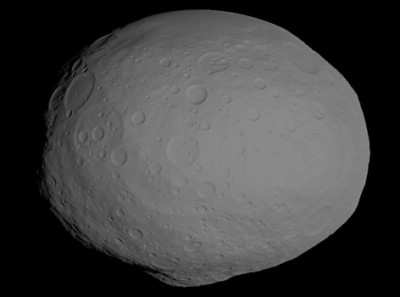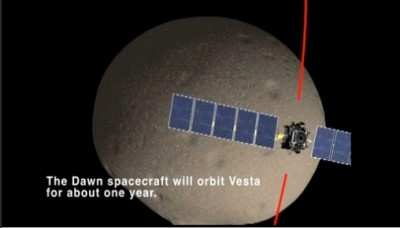When It Can Be Classified As A "Protoplanet"
On March 29, 1807, German astronomer Heinrich Wilhelm Olbers
spotted Vesta as a pinprick of light in the sky. Two hundred and
four years later, as NASA's Dawn spacecraft prepares to begin
orbiting this intriguing world, scientists now know how special the
body is, even if there has been some debate on how to classify
it.

Vesta NASA Image
Vesta is most commonly called an asteroid because it lies in the
orbiting rubble patch known as the main asteroid belt between Mars
and Jupiter. But the vast majority of objects in the main belt are
lightweights, 100-kilometers-wide (about 60-miles wide) or smaller,
compared with Vesta, which is about 530 kilometers (330 miles)
across on average. In fact, numerous bits of Vesta ejected by
collisions with other objects have been identified in the main
belt. "I don't think Vesta should be called an asteroid," said Tom
McCord, a Dawn co-investigator based at the Bear Fight Institute,
Winthrop, Wash. "Not only is Vesta so much larger, but it's an
evolved object, unlike most things we call asteroids."
The layered structure of Vesta (core, mantle and crust) is the
key trait that makes Vesta more like planets such as Earth, Venus
and Mars than the other asteroids, McCord said. Like the planets,
Vesta had sufficient radioactive material inside when it coalesced,
releasing heat that melted rock and enabled lighter layers to float
to the outside. Scientists call this process differentiation.
McCord and colleagues were the first to discover that Vesta was
likely differentiated when special detectors on their telescopes in
1972 picked up the signature of basalt. That meant that the body
had to have melted at one time.

Officially, Vesta is a "minor planet" -- a body that orbits the
sun but is not a proper planet or comet. But there are more than
540,000 minor planets in our solar system, so the label doesn't
give Vesta much distinction. Dwarf planets – which include
Dawn's second destination, Ceres -- are another category, but Vesta
doesn't qualify as one of those. For one thing, Vesta isn't quite
large enough. Dawn scientists prefer to think of Vesta as a
protoplanet because it is a dense, layered body that orbits the sun
and began in the same fashion as Mercury, Venus, Earth and Mars,
but somehow never fully developed. In the swinging early history of
the solar system, objects became planets by merging with other
Vesta-sized objects. But Vesta never found a partner during the big
dance, and the critical time passed. It may have had to do with the
nearby presence of Jupiter, the neighborhood's gravitational
superpower, disturbing the orbits of objects and hogging the dance
partners.
Other space rocks have collided with Vesta and knocked off bits
of it. Those became debris in the asteroid belt known as Vestoids,
and even hundreds of meteorites that have ended up on Earth. But
Vesta never collided with something of sufficient size to disrupt
it, and it remained intact. As a result, Vesta is a time capsule
from that earlier era. "This gritty little protoplanet has survived
bombardment in the asteroid belt for over 4.5 billion years, making
its surface possibly the oldest planetary surface in the solar
system," said Christopher Russell, Dawn's principal investigator,
based at UCLA. "Studying Vesta will enable us to write a much
better history of the solar system's turbulent youth."

Dawn's scientists and engineers have designed a master plan to
investigate these special features of Vesta. When Dawn arrives at
Vesta in July, the south pole will be in full sunlight, giving
scientists a clear view of a huge crater at the south pole. That
crater may reveal the layer cake of materials inside Vesta that
will tell us how the body evolved after formation. The orbit design
allows Dawn to map new terrain as the seasons progress over its
12-month visit. The spacecraft will make many measurements,
including high-resolution data on surface composition, topography
and texture. The spacecraft will also measure the tug of Vesta's
gravity to learn more about its internal structure.
"Dawn's ion thrusters are gently carrying us toward Vesta, and
the spacecraft is getting ready for its big year of exploration,"
said Marc Rayman, Dawn's chief engineer at NASA's Jet Propulsion
Laboratory, Pasadena, CA. "We have designed our mission to get the
most out of this opportunity to reveal the exciting secrets of this
uncharted, exotic world."
 ANN's Daily Aero-Linx (04.13.24)
ANN's Daily Aero-Linx (04.13.24) ANN's Daily Aero-Term (04.13.24): Beyond Visual Line Of Sight (BVLOS)
ANN's Daily Aero-Term (04.13.24): Beyond Visual Line Of Sight (BVLOS) Airborne 04.09.24: SnF24!, Piper-DeltaHawk!, Fisher Update, Junkers
Airborne 04.09.24: SnF24!, Piper-DeltaHawk!, Fisher Update, Junkers Aero-News: Quote of the Day (04.14.24)
Aero-News: Quote of the Day (04.14.24) ANN's Daily Aero-Term (04.14.24): Maximum Authorized Altitude
ANN's Daily Aero-Term (04.14.24): Maximum Authorized Altitude





